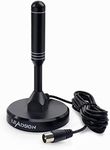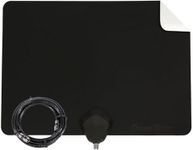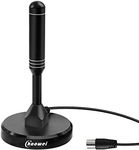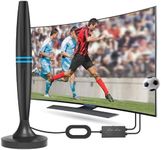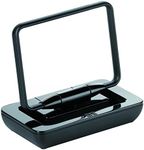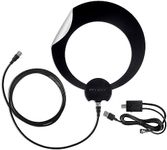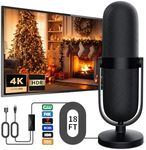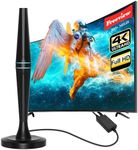Buying Guide for the Best Indoor TV Aerials
Choosing the right indoor TV aerial can significantly improve your TV viewing experience by providing better reception and access to more channels. When selecting an indoor TV aerial, it's important to consider several key specifications to ensure you get the best fit for your needs. Understanding these specifications will help you make an informed decision and enjoy clear, uninterrupted TV signals.Signal RangeSignal range refers to the distance over which the aerial can effectively receive signals from broadcast towers. This is important because it determines how many channels you can access and the quality of the reception. Signal ranges are typically measured in miles or kilometers. If you live in an urban area close to broadcast towers, a shorter range aerial (up to 20 miles) may suffice. For suburban or rural areas, you might need an aerial with a longer range (20-50 miles or more) to capture distant signals. Assess your location and proximity to broadcast towers to choose the right signal range for your needs.
Frequency BandsFrequency bands indicate the types of signals the aerial can receive, such as VHF (Very High Frequency) and UHF (Ultra High Frequency). VHF channels are typically lower in number and include major networks, while UHF channels are higher in number and may include local or specialty channels. An aerial that supports both VHF and UHF bands will provide access to a wider range of channels. If you want comprehensive coverage, look for an aerial that supports both frequency bands. If you only need access to major networks, a VHF-only aerial might be sufficient.
AmplificationAmplification refers to the aerial's ability to boost weak signals, which can be particularly useful in areas with poor reception or if the broadcast towers are far away. Amplified aerials have built-in signal boosters that enhance the strength of incoming signals, resulting in clearer picture quality and more reliable reception. Amplification is measured in decibels (dB). If you experience frequent signal issues or live in a location with weak reception, consider an aerial with higher amplification (15-30 dB). If your reception is generally good, a non-amplified or low-amplification aerial may be adequate.
Design and SizeThe design and size of the aerial can affect both its performance and how well it fits into your living space. Indoor TV aerials come in various shapes and sizes, from flat, discreet panels to larger, more conspicuous models. A compact, sleek design is ideal for small spaces or if you prefer a less noticeable setup. Larger aerials may offer better reception but can be more obtrusive. Consider your aesthetic preferences and the available space in your home when choosing the design and size of your aerial.
Ease of InstallationEase of installation refers to how simple it is to set up the aerial and start using it. Some aerials come with straightforward plug-and-play setups, while others may require more complex installation processes. Look for aerials that include clear instructions and necessary mounting hardware. If you're not comfortable with technical setups, opt for an aerial that promises easy installation. This will save you time and frustration, ensuring you can quickly enjoy your TV viewing experience.
